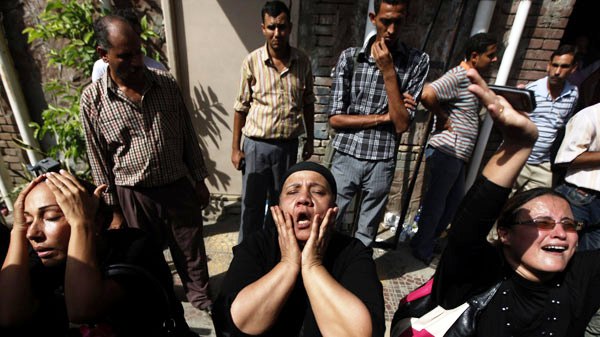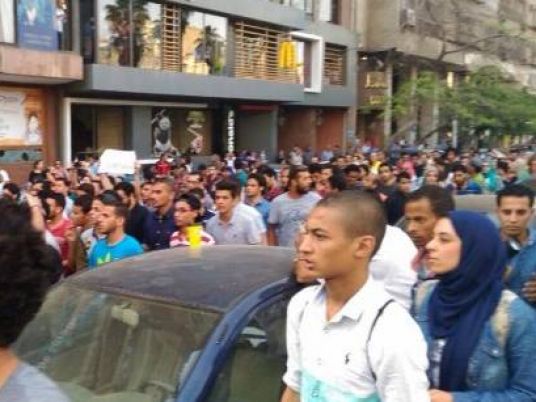
With the outbreak of new clashes between security forces and protesters around the Interior Ministry and security forces’ use of weapons such as tear gas grenades to disperse protesters, volunteers working at the front lines to reduce the impact of these weapons have resurfaced. Perhaps the most important of these volunteers are the "Yeast Knights."
The Yeast Knights first appeared during the Mohamed Mahmoud Street events in November after security forces appeared to change the type of gas they were using against the protesters. When the usual methods such as onions and cola drinks used by the protesters since the 25 January revolution seemed to fail to work against the gas, new methods to reduce the impact of this gas began to surface.
These methods included alkaline solutions such as yeast mixtures. With the increasing number of gas grenades used by the security forces, volunteers carrying spray bottles filled with yeast solution began to appear at the frontlines to spray the solution on the faces of protesters exposed to the gas.
These photos were taken in the area around the Interior Ministry, particularly on Mansour, Mohamed Mahmoud and Nubar streets, during clashes between protesters and security forces on 4 February after the Port Said massacre, which left 74 people dead.
A protester on Mansour Street carries a bucket full of used tear gas grenades.
Tear gas was first manufactured in 1871 by German scientist Carl Von Graebe and was heavily used in World War I. The gas mainly consists of solid microparticles that change into a gaseous state when released.
Tear gas causes a myriad of symptoms, ranging from coughing, a burning sensation in the respiratory passages, and tearing of the eyes. It can also lead to burns and temporary blindness in severe cases. In rare cases, in can result in continuous vomiting leading to death.
Two protesters carry a demonstrator who fell after inhaling tear gas during the Mansour Street clashes with security forces.
Some protesters use gas masks available at stores that sell industrial safety equipment. However, most of these masks do not provide adequate protection because they are used for pesticides and spray paint.
A protester wears an industrial safety mask to reduce the impact of tear gas.
Some protesters invent their own gas masks to cover their faces during exposure to the gas because it reacts with moist areas of the skin.
A protester covers his face with a newspaper, sunglasses and a medical mask to reduce the impact of tear gas.
The most common method used to combat tear gas is spraying an alkaline solution on the face and eyes, such as a mixture of yeast and water or Micogel solution.
Singer Ramy Essam receives first aid and is sprayed with yeast solution after being exposed to tear gas during clashes on Mansour Street near the Interior Ministry.
Yeast solution is one of the most popular types of solutions used by volunteers to aid the protesters, in addition to Micogel and other medical solutions available in pharmacies.
Two volunteers exchange bottles of yeast solution and Micogel used to aid protesters exposed to tear gas.
Volunteers can always be found at the front lines carrying bottles of yeast solution and Micogel to help protesters suffering from asphyxiation and face inflammation as a result of exposure to tear gas.
A volunteer comes to the aid of a frontline protester and watches as a new tear gas grenade fired by security forces falls.
Most of the volunteers spraying protesters with yeast solution are women, who usually do not fight security forces at the front lines. These women provide first aid to the injured protesters.

A female volunteer aids a protester suffering from asphyxiation after inhaling tear gas fired on Mohamed Mahmoud Street.
Perhaps the biggest problem facing the volunteers carrying yeast solution is the lack of available gas masks. However, these volunteers always come up with simple solution to this problem.

A volunteer on Mohamed Mahmoud Street wears swimming goggles and a scarf as protection against the tear gas.
Yeast solution and Micogel usually leave a white residue on the face and around the eyes after it is sprayed. This residue acts as a protective layer and helps reduce the tear gas effects on the skin on subsequent exposure.
Mohamed Mahmoud Street protesters often have residue from yeast solution on their faces.

A doctor aids a protester who inhaled tear gas on Nubar Street near the Interior Ministry.
Sometimes doctors appear at the front lines to help spray protesters with the yeast solution as well as to provide medical advice and first aid to protesters injured in the clashes.
Protesters set wood on fire in an attempt to reduce the tear gas effects on other protesters.
One of the methods found to be effective against tear gas is the lighting of fires as the resulting smoke helps protect against the tear gas.
A male and female protester fleeing from tear gas fired on Mohamed Mahmoud Street.
In spite of all the different methods invented by protesters to combat tear gas, the heavy use of gas by police forces severely impairs the effectiveness of these methods.
Translated from Al-Masry Al-Youm














